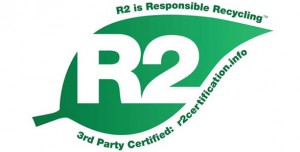
ALL MATERIALS ARE RECYCLED TO U.S. EPA STANDARDS. YOUR DATA SECURITY IS FINAL WITH TECH eWASTE.
Tech-eWaste partners with U.S. EPA “R2 Certified” eWaste recyclers. These recyclers maintain their R2 certification by rigorously adhering to the highest environmental and electronics recycling standards issued by the U.S. Environmental Protection Agency. To learn more about EPA R2 recycling standards click the green R2 leaf.
Tech-eWaste employs a “closed loop recycling process” to insure “zero breach” of security with the data held in the electronics you are recycling. From the moment we remove Tech-eWaste from your premises to the moment it is received and inventoried by our Certified Recycler, it’s held secure. It begins when we accept your electronics for recycling. The items are held or transported to our facility in San Francisco, where they are sorted and prepared for movement to the appropriate R2 recycler by equipment type. The recycle and dismantle process is different for each type of electronics. Click this Video to watch the recycling process at Sims Metal, which recycles the steel and computer related equipment for Tech-eWaste. By default all data holding equipment in the recycle stream is destroyed and resorted to its base composite by the respective recyclers below. Tech-eWaste has the ability to perform an immediate onsite “data quarantine” of your equipment onsite. This involves a drill-thru of your hard drive on your premises (near 100 percent destroyed). Complete and documented physical destruction of any data holding device can be made at our sorting facility within 48 hours of receipt. Please make requests for Data Destruction Certificates before pick up or received of your Tech-eWaste. There will be no charge for the certificate.
Below is a list Tech-eWaste EPA R2 certified partners and the devices and materials they recycle for us. Included are the methods used for data destruction, recycling, and the re-purposing of materials for use in new products.
CRT Glass TV’s, CRT Computer Monitors, Flat Screen Monitors
ECS REFINING
Cathode Ray Tube (CRT) televisions and monitors make up a significant portion of the global electronic waste stream. They possess nominal commodity value, and because they contain leaded glass, CRT devices are difficult and costly to recycle. As a result, CRTs are often exported to be dismantled and discarded in regions with substandard environmental protection and labor laws.
ECS Refining offers one of the few complete domestic solutions for CRT devices and boasts the most sophisticated, full-circle recycling process in the world.
CRT Dismantling
The first stage in ECS Refining CRT recycling process is to separate the bare cathode ray tube from its enclosure. The glass tubes need to be in tact when they enter the glass separation stage, so monitors and televisions must be dismantled manually. Once the bare CRT has been removed, the remaining components enter the electronics recycling process where they are shredded and separated into various commodity types including plastic, copper, printed circuit board, and steel. These are sold into secondary markets to be remanufactured into new products, and the bare cathode ray tube moves on to be further refined into clean glass.
CRT Glass Separation
The second stage in the CRT recycling process utilizes a proprietary technology that separates the lead-bearing glass (known as the funnel) from the clean glass (known as the panel). This CRT glass separation process is highly efficient and allows ECS to isolate the glass types with unprecedented accuracy. The panel glass, which is high in quality, can be refined and reused for a number of applications, including the automotive, fiberglass, bead, and lighting industries. The leaded funnel glass proceeds to the final smelting stage where the lead is removed.
CRT Glass Smelting
The final smelting stage is similar to the secondary lead smelting process that many other recyclers use in that the lead-bearing funnel glass is heated to a molten state so the lead can be extracted. Once it has been extracted, the lead is formed into ingots and sold as commodities. However, unlike the other leaded smelters, this process does not result in useless slag that must be discarded in landfills. Instead, ECS Refining “re-nourishes” the melted glass after removing the lead. This proprietary process produces clean, new glass that can be used for countless applications.
ECS Refining specializes in end-of-life electronics recycling, the process by which obsolete electronic devices are dismantled and separated into clean, reusable commodities. Unlike other recyclers, ECS is able to efficiently and effectively process large volumes of end-of-life electronics (also known as e-waste) utilizing automated recycling equipment and cutting-edge technology. Our state-of-the-art electronics recycling facilities, which are e-Stewards and R2 Certified, are designed to maximize materials recovery and eliminate harmful waste while and safeguarding our workers and environment.
ECS provides downstream electronics recycling services to a variety of markets, including electronics recyclers and collectors, manufacturers, large businesses, and the private sector.
Shredding
G.I.G.O: The principle of “Garbage In, Garbage Out” also applies to efficient and effective electronics recycling. Although ECS is capable of recycling a wide range of material streams, many of our processes are optimized for electronic waste. This means that non-conforming materials could disrupt the streamlined recycling process or contaminate the commodity outputs. Click here to learn more about what we recycle.
Pre-picking: Our end-of-life electronics recycling process begins with a conveyor line in which items that should not be shredded, such as batteries, UPS battery systems, toner cartridges, and fluorescent lights, are removed by hand before they enter the main shredder.
Shredding: After tech-ewaste has been pre-picked, it flows into the shredding line to be sized down for commodity separation. The primary shredder breaks material down into 4” x 10” fragments and the secondary shredder reduces it further into poker chip-sized fragments that are optimal for the separation processes.
Separation and Refining
Effective and efficient commodity separation is a key component of end-of-life e-waste recycling that largely determines the value that can be recovered. ECS Refining boasts a state-of-the-art separation process that is unparalleled in the industry.
After tech-ewaste has been shredded into optimally-sized fragments, it enters the separation lines where it is segregated into various commodity types using sophisticated technologies including eddy currents, optical identification, and magnetic separation. The first separation stage divides material into plastics and metals, and the second stage further separates the metal stream into different varieties. ECS Refining state-of-the-art recycling process ensures that the electronics are refined into clean, high-quality commodities.
Computer and Communications Circuit Boards, Memory Boards, Cell Phones

Sims Metal Management utilizes highly sophisticated machinery and advanced technology to convert whole electronic devices to the base commodities which they are derived from. Sims utilizes a system where “end of life” electronics are mechanically grinded into whole chips to a size just larger than a quarter. Ultra modern sorting systems utilize optical eyes to sort these pieces of material on conveyor belts and send them downstream into their respective commodity type. The commodities recovered such as circuit boards, various metals and plastics are then further processed to be re-purposed for new products. In this process any and all data storing devices, whether built in, or portable, are disintegrated. See the Sims Guarantee.
Sims Metal is the largest steel recycler in the World. The materials listed above are largely presorted before Tech-eWaste guy delivers them for recycling at Sims Metal Management.
Recent Comments